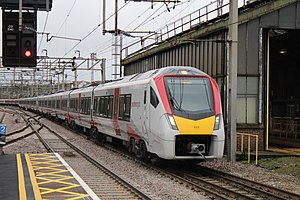 Class 745 at Colchester in February 2020 | |
| Overview | |
|---|---|
| Franchise(s) | Greater Anglia 5 February 2012 – 15 October 2016 East Anglia 16 October 2016 – 20 September 2026 |
| Main region(s) | East of England |
| Other region(s) | Greater London |
| Fleet size | |
| Stations called at | 150 |
| Stations operated | 134 |
| Parent company | Transport UK Group (60%) Mitsui & Co (40%) |
| Reporting mark | LE[1] |
| Predecessor | National Express East Anglia |
| Other | |
| Website | www |
Greater Anglia (legal name Transport UK East Anglia Limited)[3] is a British train operating company owned as a joint venture by Transport UK Group and Mitsui & Co. It operates the East Anglia franchise, providing the commuter and inter-city services from its central London terminus at London Liverpool Street to Essex, Suffolk, Norfolk and parts of Hertfordshire and Cambridgeshire, as well as many regional services throughout the East of England.
Abellio began operating the franchise, then known as the Greater Anglia franchise, replacing the National Express franchise on 4 February 2012. Initially, it traded under the same name until it rebranded as Abellio Greater Anglia in December 2013. Shortly after taking over operations, the company initiated a series of projects to improve service levels, including the procurement of new trains and the launch of the Norwich in 90 programme to reduce travel times between several major locations on its network. In May 2015, Greater Anglia's suburban rail services were transferred to London Overground and the precursor to Crossrail, TfL Rail.
The franchise was retendered as the East Anglia franchise and was awarded to Abellio in August 2016. The company resumed trading as Greater Anglia on 16 October 2016 when the new franchise commenced. In January 2017, Abellio announced that subject to gaining Department for Transport approval, it had agreed to sell a 40% stake in the business to Mitsui. Since the completion of the sale in March 2017, Greater Anglia has incorporated several Japanese planning tools and practices. Trade unions have objected to some of the changes made by the company, leading to industrial action in 2017 and 2018 as a result of the dispute.
- ^ "Greater Anglia". National Rail Enquiries. National Rail. Archived from the original on 23 April 2021. Retrieved 30 April 2021.
- ^ "The distorted rolling stock market". Modern Railways. No. 900. September 2023. p. 38.
- ^ "Companies House extract company no 7861414: Abellio East Anglia Limited". companieshouse.gov.uk. Archived from the original on 27 January 2022. Retrieved 23 January 2021.